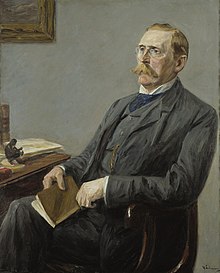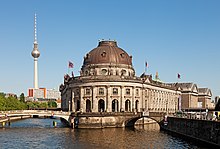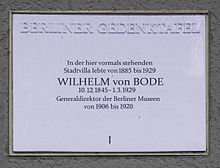Wilhelm von Bode

Wilhelm von Bode (born December 10, 1845 in Calvörde ; † March 1, 1929 in Berlin ), born in Arnold Wilhelm Bode , ennobled in 1914, was an important German art historian and museum specialist and is considered to be the co-founder of modern museums . Bode was one of the central figures in German culture in the late 19th and early 20th centuries. In 1904 he founded the Kaiser Friedrich Museum (today the Bode Museum ) on Museum Islandin Berlin, was general director of the state art collections and created fundamental works on the history of German, Dutch and Italian painting and sculpture . Because of his decisive influence on the development of Berlin's art collections, he was also called "Museum Condottiere" and "Bismarck of the Berlin Museums". From 1889 to 1914 he also led the re-establishment of the urban art collections of the city of Strasbourg, which were destroyed in the Franco-Prussian War .
Life
Bode's parents were the judge Wilhelm Bode and his wife Emilie geb. Rimpau (1820–1894), a sister of the agricultural politician Wilhelm Rimpau . In his first marriage, Bode was married to Marie Rimpau, a daughter of the aforementioned Wilhelm Rimpau and his wife Sophie Bode, from 1882. She was his paternal and maternal cousin at the same time. In his second marriage, he was married from 1894 to Anna von Gmelin, a daughter of the Württemberg lawyer and Senate President Wilhelm von Gmelin and his wife Agathe Bruns. Bode had three daughters in total. Including Marie Bode, who married Viktor Bruns in 1915 .
After graduating from high school in Braunschweig , Bode began to study law at the University of Göttingen in 1863 . In 1865 he was reciprocated in the Corps Brunsviga Göttingen . When he was inactive , he moved to the University of Berlin . His interest in art history was already evident when he finished studying law in 1867 . During his internship in Braunschweig, he organized some of the ducal art collections systematically. During this time he began to travel to Dutch and Belgian museums and private collections, but also to Italy . After his (incomplete) auditor (assessor) time, he studied art history and archeology in Berlin and Vienna . As an auditor he was only on leave and officially remained “ ducal auditor on leave ” until his death . In 1870 he received his doctorate in Leipzig with a dissertation on Frans Hals and his school .
In 1872 he took up his position as assistant in the sculpture department of the royal museums in Berlin , of which he became director in 1883. In 1889 he was entrusted with the management of the restocking of the Strasbourg art collections, which he dealt with until the outbreak of the First World War . His efforts gave rise to the foundations of the collections of the Musée des Beaux-Arts de Strasbourg , the Graphics Cabinet Strasbourg , the Musée des Arts décoratifs de Strasbourg , the Musée de l'reuvre Notre-Dame and, to a lesser extent, the Musée d'Art Moderne et Contemporain de Strasbourg . From 1890 he also headed the Berlin picture gallery . He became general director of the Royal Museums in Berlin in 1905. His art-historical competence and his excellent relationships with artists and collectors as well as the imperial family enabled him to make spectacular purchases right from the start - despite the initially modest means. The highest boss of the Museum Island was the Crown Prince Friedrich .
At the beginning of his tenure, Berlin as the new capital in the field of art could not compete with Munich or Dresden, let alone with Paris and the Louvre. Initially motivated by a chronic Prussian lack of money for art, Bode established an international network of collectors, donors and patrons throughout his life. Starting with around 50 Berlin private collectors such as James Simon , Adolph Thiem , Louis Fréderic Jacques Ravené (pointedly portrayed by Theodor Fontane in the novel L'Adultera ), Oscar Hainauer , Oscar Huldschinsky , Eduard Georg Simon , Eugen Gutmann , Paul Davidsohn, August von der Heydt , Jacques Mühsam , Marcus Kappel , Leopold Koppel , Eduard Arnhold , Carl von Hollitscher , Bode was looking for more and more collectors who lived according to the motto of his pupil Max J. Friedländer : “ Owning art is pretty much the only decent kind that is permitted by good taste To present wealth . ”His relationship with James Simon, probably the most important private collector for Bode, with whom he also worked in the German Orient Society, is exemplary. With Simon's consent, Bode advised him on building his collection so that the works of art could usefully supplement the holdings of the state museums if they were later donated.
In 1883, Bode presented fifty Berlin collectors with three hundred works of art from their possession at the Akademie der Künste . He had written the catalog. Berlin's cultural climate grew through Bode's activities, and the antique trade flourished. New feuilletons appeared from the newly founded art editorial offices, the best-known representatives of which were Julius Meier-Graefe , Fritz Stahl , Adolf Behne , Karl Scheffler , Max Osborn , Adolph Donath and, last but not least, Ludwig Pietsch . Berlin's major newspaper publishers like Rudolf Mosse began collecting art. In 1887 Bode founded "The Berlin Art History Society". He was assisted by Friedrich Lippmann , director of the Kupferstichkabinett , and Robert Dohme , house librarian of Kaiser Wilhelm I , who was also director of the art collections of the Prussian royal family.
Bode got on well with Kaiser Wilhelm II and was able to ward off many intrigues against himself. So he supported at the beginning of the First World War a. a. the emperor together with many other intellectuals in the manifesto of the 93 . Through skilful coffee-wreath diplomacy , in which Bode used the emperor's coffee visits to encourage patronage, Bode gained many memberships to his " Association of Friends of the Kaiser-Friedrich-Museum ". In analogy to the popular phrase " Whoever eats breakfast with the Pope must have settled with his life ", the Berliners varied: " Anyone who drinks coffee with SM (His Majesty) must have settled with his pictures ." The " Kaiser Friedrich-Museums-Verein " became a model for many similar organizations in other museums. In this way he succeeded in building up a worldwide unique, systematically structured collection of sculptures with a special focus on works from the Italian Renaissance as well as expanding the picture gallery to include works by Italian, Spanish, French, English and German masters, including major works by Rembrandt , Rubens and Dürer .

Von Bode was involved in setting up and expanding numerous other departments, such as the Kupferstichkabinett and the coin collection , the Islamic and East Asian departments, the archaeological and Egyptian collections. He also advised private collectors and regional museums on acquisitions. As general director, he initiated the planning of the "Museum of Older German Art", known as the Deutsches Museum , as well as the expansion of the antiquities collection and the Middle East Museum , which together with the present-day Museum of Islamic Art in the Pergamon Museum planned by Alfred Messel and Ludwig Hoffmann since 1907 were summarized. For the Völkerkundemuseum , today's Ethnological Museum , and today's Museum of Asian Art , he initiated the construction of the Dahlem Museum Center according to the plans of the architect Bruno Paul . For the Kaiser Friedrich Museum, which was inaugurated in 1904, and the Deutsches Museum, which was handed over in 1930, he developed the concept, which was particularly popular in the USA , of equipping each room with paintings, sculptures, furniture, and original architectural fragments from an era , thereby eliminating the separation of art genres .
Today, Bode's repeatedly proven practice of having been pleasing to art dealers and private collectors through personal consultations or reports and catalogs of their collections written by him is more critically assessed, for which they then reciprocated with spectacular donations or substantial financial contributions to the Berlin museums. This close sponsorship relationship is known as "System Bode". In acquiring one after his conviction by Leonardo da Vinci derived wax bust of Flora - which had been but probably made by an English sculptor in 1850 - sparked Bode one years and Europe led coalition in 1909 over connoisseurship and authenticity questions to which more than 700 newspaper articles published.
His works on Dutch painting and Italian sculpture, some in many volumes, have long been regarded as standard works in his field. His art-historical judgment counted in the professional world, among other things he was one of the experts at the Dresden Holbeinstreit . Thanks to his work, the Berlin museums have become one of the most important museum complexes in the world, comparable to the Kunsthistorisches Museum in Vienna, the Louvre in Paris , the Hermitage in Saint Petersburg , the National Gallery in London, the British Museum and the Metropolitan Museum in New York.
In 1925 he was elected honorary member of the Prussian Academy of Sciences . Since 1891 he was a corresponding member of the Bavarian Academy of Sciences .
Bode has been portrayed by a number of prominent painters, including Max Liebermann , Ernst Oppler, and the Dutchman Jan Veth . The sculptor Adolf von Hildebrand created a marble bust in 1901. The sculptor Josef Thorak created a portrait bust around 1929.
Bode is buried in the Luisen-Friedhof II in Berlin. His grave has been dedicated to the city of Berlin as an honorary grave since November 2018 .
Publications
- Frans Hals and his school. A contribution to a critical treatment of Dutch painting . Leipzig 1871 ( digitized ).
- History of German sculpture . 1887 (Reprinted by Salzwasser-Verlag, Paderborg 2012, ISBN 978-3-86444-206-3 ).
- L'oeuvre complet de Rembrandt. Reproduction par l'héliogravure de tous les tableaux du maître, accompagnée de leur histoire, de leur description et d'une étude biographique et critique . Avec le concours de Cornelis Hofstede de Groot . Traduite by Auguste Marguillier. 8 volumes, Charles Sedelmeyer, Paris 1897–1905.
- Near Eastern knotted carpets from older times . Leipzig 1901, 2nd edition with Ernst Kühnel 1914, 3rd edition Leipzig 1922.
- Arts and crafts at the end of the nineteenth century . Berlin 1901.
- Florentine Sculptors of the Renaissance , 1902, 4th edition 1921.
- Rembrandt and his contemporaries: character pictures of the great masters of the Dutch and Flemish school of painting in the seventeenth century. 2nd, presumably edition. Leipzig 1907.
- (Ed.) Frans Hals. His life and works . Text by MJ Binder. 2 volumes, Berlin 1914
- The works of the della Robbia family. Berlin 1914.
- The masters of the Dutch and Flemish schools of painting . 1917, 9th edition 1958.
- Sandro Botticelli. Berlin 1922.
- The Italian bronze statuettes of the Renaissance. Small, rework. Edition Berlin 1922.
- The Italian plastic. 6th edition Berlin [u. a.] 1922.
- Fifty years of museum work . Velhagen & Klasing, Bielefeld / Leipzig 1922; Text archive - Internet Archive .
- The sculptor Joseph Thorak . JJ Otten, Berlin-Frohnau 1929; archive.org
- My life . 2 volumes. Berlin 1930.
literature
- Ignaz Beth : Directory of the writings of Wilhelm v. Bode. Berlin [u. a.] 1915.
- Adolph Goldschmidt : On the 70th birthday of W. von Bode. Berlin 1916.
- Major works from the Berlin State Museums. In honor of Wilhelm von Bode . Edited by the department heads. Berlin 1926.
- Frida Schottmüller : Wilhelm von Bode [obituary]. In: Research and Progress , Volume 5, 1929.
- Paul Fechter: Wilhelm von Bode. In: Paul Fechter: At the turn of time. Gütersloh 1949, pp. 451–456.
- Ludwig Justi: Bode, Arnold Wilhelm von. In: New German Biography (NDB). Volume 2, Duncker & Humblot, Berlin 1955, ISBN 3-428-00183-4 , p. 347 f. ( Digitized version ).
- Wilhelm von Bode as a contemporary of art: for his 150th birthday. Nationalgalerie Staatliche Museen zu Berlin, exhibition from December 9th to February 25th 1996. Berlin 1995.
- Friedrich Künzel: Directory of the written estate of Wilhelm von Bode. Berlin 1995.
- Volkmar Enderlein : Wilhelm von Bode and the Berlin carpet collection . Berlin 1995, ISBN 3-7861-1908-2 .
- Manfred Ohlsen: Wilhelm von Bode: between imperial power and art temple. Biography. 2nd Edition. Berlin 2007.
- Sven Kuhrau: The art collector in the empire. Art and representation in Berlin's private collector culture. Ludwig, Kiel 2005, ISBN 3-937719-20-2 .
- Ulrike Wolff-Thomsen: The wax bust of a flora in the Berlin sculpture collection and the Wilhelm Bode system. Leonardo da Vinci or Richard Cockle Lucas? Kiel 2006, ISBN 978-3-937719-42-9 .
- Joanna Winiewicz-Wolska: "I would be very grateful for a few lines of information ..." Karl Lanckoroński and Wilhelm von Bode. In: Yearbook of the Scientific Center of the Polish Academy of Sciences in Vienna , Vienna 2015, pp. 19–48.
Web links
- Literature by and about Wilhelm von Bode in the catalog of the German National Library
- Works by and about Wilhelm von Bode in the German Digital Library
- Newspaper article about Wilhelm von Bode in the 20th century press kit of the ZBW - Leibniz Information Center for Economics .
- Works by Wilhelm von Bode in Project Gutenberg ( currently usually not available for users from Germany )
- Works by Wilhelm von Bode in the Internet Archive
- Wilhelm von Bode digitized literature in the “History of Art History” portal in Arthistoricum.net
- Short biography of Wilhelm von Bode . In: Who's Who.de
- Claire Guinomet: Wilhelm von Bode - passionate art historian and collector . In: Blog of the Staatliche Museen zu Berlin , February 3, 2017
- Dictionary of Art Historians
- Works by Wilhelm von Bode in the Gutenberg-DE project
Individual evidence
- ↑ Kösener Corpslisten 1930, 41/547.
- ^ Art History Society of Berlin ( Memento from September 13, 2016 in the Internet Archive )
- ^ Members of the previous academies. Wilhelm von Bode. Berlin-Brandenburg Academy of Sciences and Humanities , accessed on February 24, 2015 .
- ^ Member entry by Wilhelm von Bode at the Bavarian Academy of Sciences , accessed on January 1, 2017.
- ^ Yearbook of the Berlin Museums , p. 244, 1996
- ↑ Shown in Bode's work The Sculptor Joseph Thorak , Berlin 1929.
- ^ English edition The Complete Work of Rembrandt - History, Description and Heliographic Reproduction of all the Masters Pictures with a Study of his Life and his Art , the Text by Wilhelm Bode, assisted by Cornelis Hofstede de Groot, from the German by Florence Simmonds. 8 volumes. Charles Sedelmeyer Publishers, Paris 1897–1906.
- ^ English edition Frans Hals - His Life and Work , edited by Wilhelm von Bode, with an essay by MJ Binder. 2 volumes. Photographische Gesellschaft, Berlin 1914 (printed in 235 copies).
| personal data | |
|---|---|
| SURNAME | Bode, Wilhelm von |
| ALTERNATIVE NAMES | Bode, Arnold Wilhelm von |
| BRIEF DESCRIPTION | German art historian and museum director |
| DATE OF BIRTH | December 10, 1845 |
| PLACE OF BIRTH | Calvörde |
| DATE OF DEATH | March 1, 1929 |
| Place of death | Berlin |




